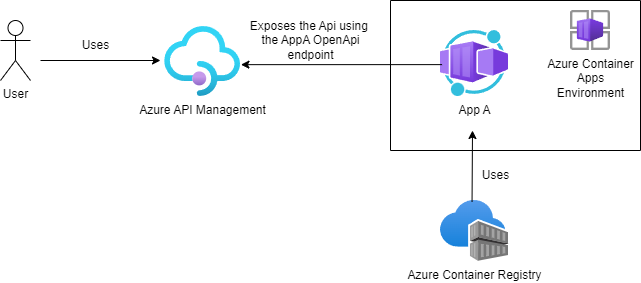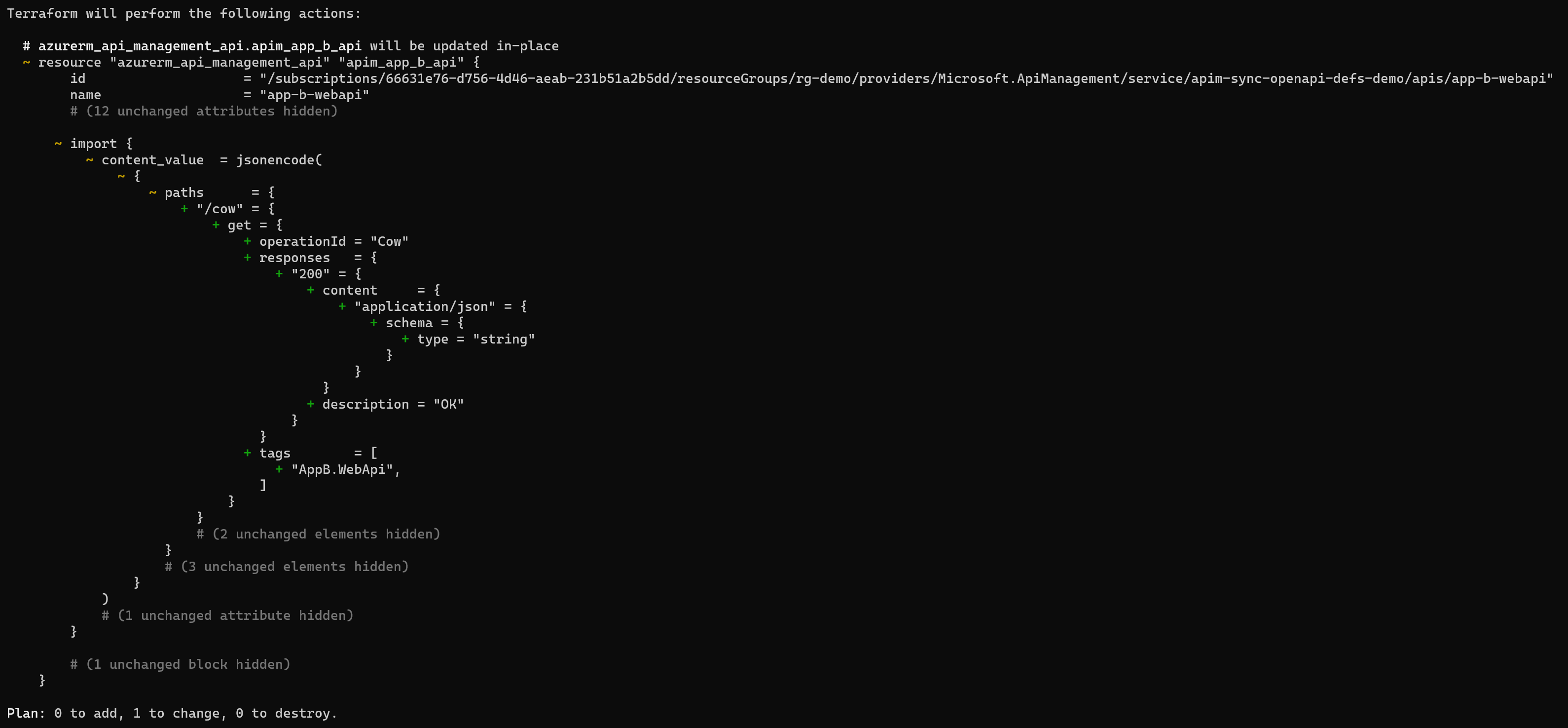How to update an Azure API Management API that is configured with a remote OpenApi definition using Terraform
This repository provides an example of how to update an Azure API Management API configured with a remote OpenAPI definition using Terraform.
In this demo we utilize Azure Container Apps to host our APIs, but it could be any service (Azure App Service, ACI, Azure VM, or even a service from another Cloud). The hosting platform is not relevant; the important part is to expose the app in Azure API Management using the API's remote Swagger endpoint.
This repository contains a set of Terraform files that creates the following components.
- An Azure Container Registry to host the application's images.
- An Azure Container Apps Environment to host the applications.
- Two Azure Container Apps running a simple .NET 8 API. Both apps expose the OpenAPI document through the
/swagger/v1/swagger.jsonendpoint. - An Azure API Management.
- Two Azure API Management APIs. Both API Management APIs are configured to retrieve its content from the Container Apps swagger endpoint.
How we can update an Azure API Manamgent API that is using a remote OpenApi definition using Terraform?
The next Terraform code snippet shows the simplest way to create an Azure API Management Api configured with a remote OpenAPI definition.
resource "azurerm_api_management_api" "apim_app_a_api" {
name = "app-a-webapi"
resource_group_name = azurerm_resource_group.rg.name
api_management_name = azurerm_api_management.apim.name
revision = "1"
display_name = "app-a-webapi"
path = "app-a"
protocols = ["https"]
service_url = "https://${azurerm_container_app.aca_app_a.ingress[0].fqdn}"
subscription_required = false
import {
content_format = "openapi+json-link"
content_value = "https://${azurerm_container_app.aca_app_a.ingress[0].fqdn}/swagger/v1/swagger.json"
}
}As you can see the import block is configured to retrieve content from the remote API /swagger/v1/swagger.json endpoint.
However, this scenario poses a problem.
If someone makes a change to the remote API that modifies the swagger content, such as exposing a new method or altering an existing method, running the terraform plan command will reveal that Terraform is unable to detect changes in the remote API.
Consequently, it won't update the API definition in the Azure API Management to reflect the modifications.
To force the update on the Azure API Management API we have 2 options available.
The revision property is used to make non-breaking API changes to your API, so you can test changes safely. The usual process involves deploying a new revision, conducting tests, and eventually transitioning from the old to the new revision.
However, we can repurpose this property to instigate the destruction and recreation of the current exposed API on the API Management. While the original intent of the revision property is to maintain multiple revisions simultaneously, updating the revision property of the current API triggers the recreation of the current resource, serving our purpose in this context, because when the API gets recreated, it will fetch the updated content from the /swagger/v1/swagger.json endpoint.
In the following code snippet, the revision property has been modified from 1 to 2, triggering the destruction of the existing Azure Api Management Api and the creation of a new one with the updated revision property.
Once the new Azure API Management API is created, it will retrieve the latest content from the https://${azurerm_container_app.aca_app_a.ingress[0].fqdn}/swagger/v1/swagger.json endpoint.
resource "azurerm_api_management_api" "apim_app_a_api" {
name = "app-a-webapi"
resource_group_name = azurerm_resource_group.rg.name
api_management_name = azurerm_api_management.apim.name
revision = "2"
display_name = "app-a-webapi"
path = "app-a"
protocols = ["https"]
service_url = "https://${azurerm_container_app.aca_app_a.ingress[0].fqdn}"
subscription_required = false
import {
content_format = "openapi+json-link"
content_value = "https://${azurerm_container_app.aca_app_a.ingress[0].fqdn}/swagger/v1/swagger.json"
}
}The Terraform http data resource makes an HTTP GET request to a given URL and exports information about the response.
In the next code snippet, we utilize the Terraform data http resource to retrieve the content from the remote Swagger endpoint. Subsequently, we use the output to configure the Azure API Management API.
data "http" "apim_app_b_openapi" {
url = "https://${azurerm_container_app.aca_app_b.ingress[0].fqdn}/swagger/v1/swagger.json"
request_headers = {
Accept = "application/json"
}
}
resource "azurerm_api_management_api" "apim_app_b_api" {
name = "app-b-webapi"
resource_group_name = azurerm_resource_group.rg.name
api_management_name = azurerm_api_management.apim.name
revision = "1"
display_name = "app-b-webapi"
path = "app-b"
protocols = ["https"]
service_url = "https://${azurerm_container_app.aca_app_b.ingress[0].fqdn}"
subscription_required = false
import {
content_format = "openapi+json"
content_value = data.http.apim_app_b_openapi.response_body
}
}- However, what's the advantage of this scenario over the previous one?
The primary advantage of utilizing the Terraform http resource is that there is no need to manually modify the revision property in our Terraform files when someone makes a change to the remote API that modifies the Swagger content.
In the first scenario, we had to manually change the revision property to trigger the recreation of the API Management API resource.
By employing the Terraform data http resource, no modifications are required in our Terraform files. The http resource ALWAYS fetchs the content from the remote Swagger endpoint whenever a terraform plan command is executed.
The following image illustrates this concept. We've introduced a modification to the downstream API, and when the terraform plan command is executed, Terraform seamlessly detects the change and updates the API Management API, thanks to the data http resource.
- Which scenario is better?
To keep always the most up-to-date version of your APIs exposed in your API Management, use the http resource, it is a better choice, as it eliminates the need to modify anything in your Terraform files.
While the revision property can be utilized in this context, it is more apt for a different scenario: maintaining multiple revisions of the same API simultaneously and facilitating non-breaking changes to the current API.
Keep in mind that if you opt to have multiple revisions of your API at the same time, creating a new revision after the content of the remote Swagger has been updated won't include those changes.


